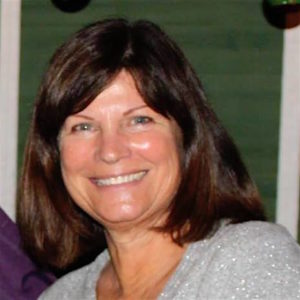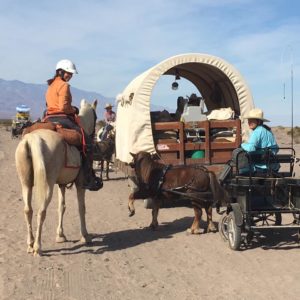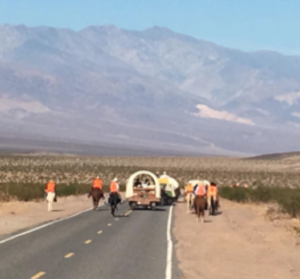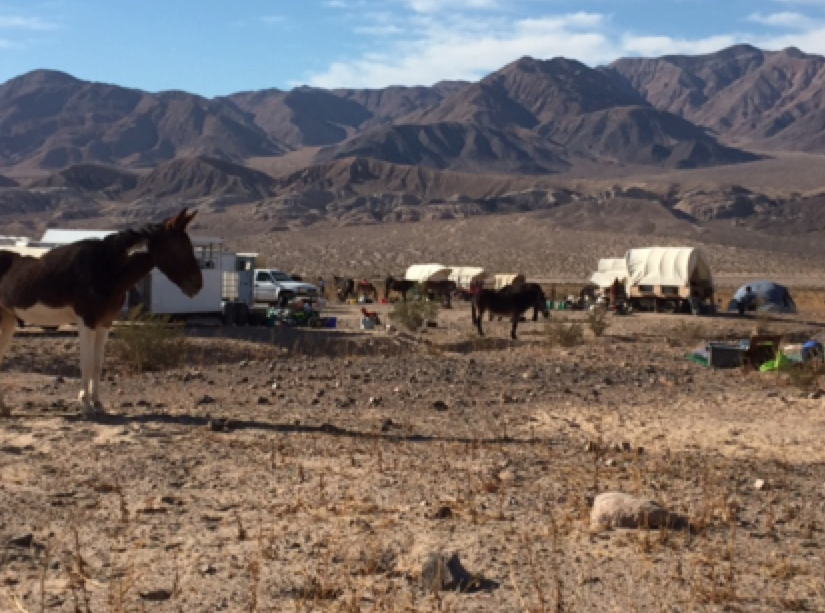Editor’s Note: In the fourth installment of a multi-part series, we hear from Jeanette Hayhurst, a long-time and avid horsewoman from Barstow, California. Like many of us, she has continued to connect with horses, even when her age and physical limitations kept her from doing a lot of riding. Kudos, Jeanette!
 She writes of her transition from riding to driving and owning a miniature horse. Earlier this month, she participated in her second Death Valley drive with two miniature horses. We hope to hear about it soon!
She writes of her transition from riding to driving and owning a miniature horse. Earlier this month, she participated in her second Death Valley drive with two miniature horses. We hope to hear about it soon!
Enjoy this multi-part series of her first drive through Death Valley.
By Jeanette Hayhurst
 The day had finally arrived for our 60-mile Death Valley experience. We pulled out of Barstow, California, and headed for Ashford Junction to meet up with the other participants. Since this was the 50th anniversary of the Death Valley ‘49ers Encampment, some of the wagons had left five days earlier from Wade’s Monument. They’d be on the road for a total of ten days and would travel 100 miles.
The day had finally arrived for our 60-mile Death Valley experience. We pulled out of Barstow, California, and headed for Ashford Junction to meet up with the other participants. Since this was the 50th anniversary of the Death Valley ‘49ers Encampment, some of the wagons had left five days earlier from Wade’s Monument. They’d be on the road for a total of ten days and would travel 100 miles.
When we pulled into Ashford Junction that afternoon, the four wagons from Wade’s Monument had already arrived. Their wagons were parked, their animals were staked out, and they were settled in.
Step One: find a place to park the rig.
Next: unload my horse and wagon and set up my tent.
The temperature was warm with no wind so things went smoothly. Danny settled in nicely and ate his pre-soaked pellets. I used the water from my horse trailer tank to give him a bucket of water that I set at the edge of his stake-out line. We would spend two nights here so the Wade’s Monument animals could have a layover day and the rest of us could settle in.
 This was a great opportunity to look at everyone’s rigs and meet the teamsters and their swampers. (Each of the wagon drivers had a swamper that would jump down off the wagon to hold the teams and assist as needed.) Most of the wagons were pulled by mules, ranging in size from pony mules to draft mules. Two sets of wagons pulled by pairs of black Percherons. One wagon was powered by three-up of Haflingers.
This was a great opportunity to look at everyone’s rigs and meet the teamsters and their swampers. (Each of the wagon drivers had a swamper that would jump down off the wagon to hold the teams and assist as needed.) Most of the wagons were pulled by mules, ranging in size from pony mules to draft mules. Two sets of wagons pulled by pairs of black Percherons. One wagon was powered by three-up of Haflingers.
The majority of the outriders rode horses but some rode mules.
On our first day, I was up at daybreak and fed my horse. I packed up my tent and belongings and cleaned up after Danny. I was the “new kid” and I wasn’t about to keep anyone waiting. Per Corral 14’s agreement with the National Park Service, once we pulled out, the support team would “clean up” and restore the area so it looked like we were never there. There were three support vehicles to haul water, feed and supplies. One was a U-Haul truck and then another rig towed the “comfort wagon” which included a port-a-potty/shower combo. The last vehicle towed a stock trailer just in case one of the equines had trouble and needed a ride. Each of the four travel days we would average about 15 miles. Day Three would be a layover day to rest the stock and humans.
 I watched each of the wagons methodically load up all of their stuff. The big wagons were “self-contained” and hauled their own bedding, food and supplies. Danny was already pulling his own weight with me and the wagonette, so I loaded my gear into one of the support trucks along with the outriders. I put on Danny’s hoof boots and harness. Once the others began to hitch up their teams, I hooked Danny up to his wagonette.
I watched each of the wagons methodically load up all of their stuff. The big wagons were “self-contained” and hauled their own bedding, food and supplies. Danny was already pulling his own weight with me and the wagonette, so I loaded my gear into one of the support trucks along with the outriders. I put on Danny’s hoof boots and harness. Once the others began to hitch up their teams, I hooked Danny up to his wagonette.
Just like most group trail rides, the energy is always a little high on Day One. Since we were going to be traveling along paved highway for the first few miles, outriders wore orange vests. It was their job to scope out the route and stop traffic when needed. I knew Danny and I needed to be toward the back so I circled off to the side as the wagons headed out. We did have a support vehicle with flashing lights at the back to help keep us safe.
I couldn’t believe I was really doing this! I reflected on how my preparation had paid off. Danny went well in the trailer and had no trouble staking out. He ate and drank well, so I didn’t have to worry. It was easy to get his hoof boots on and get him harnessed up. There are a lot of moving parts to make the trip go smoothly so I was glad I addressed the things I could control because, as I would soon find out, there are always things you cannot control.
